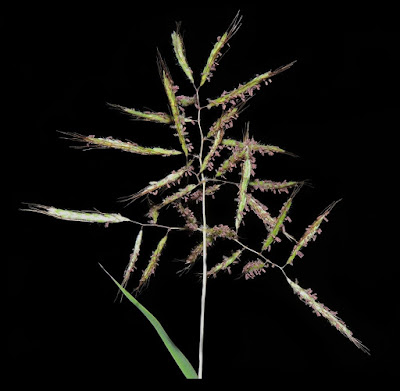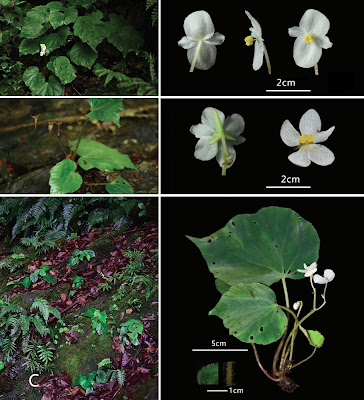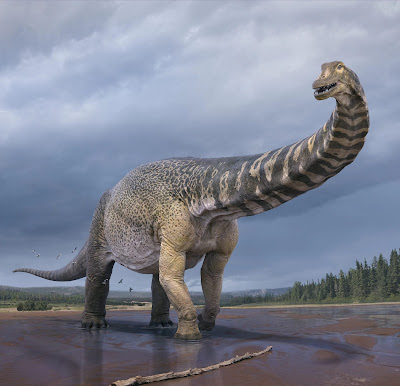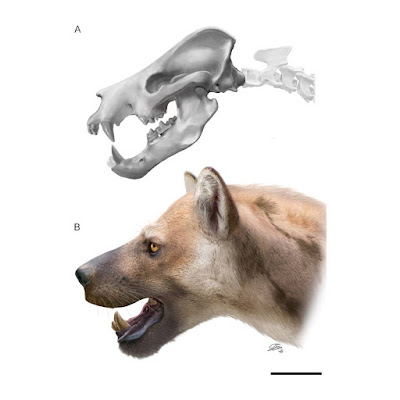[Most Recent Entries] [Calendar View]
Tuesday, June 8th, 2021
| Time | Event | ||
| 7:02a | [Botany • 2021] Capillipedium yashwantraoi (Poaceae) • A New Species from Madhya Pradesh, India
Abstract New species in the genus Capillipedium Stapf is described and illustrated from Amarkantak hills of Madhya Pradesh, India. New species is similar to Capillipedium assimile (Steud.) A.Camus and C. nagense Bor but mainly diverges by having 4–6 cm panicle, 2–2.5 cm racemes, about 11–13 pairs of sessile and pedicelled spikelets in each raceme; joints and pedicels without translucent groove, 2–2.5 mm sessile spikelets and 3–3.2 mm pedicelled spikelets. A taxonomic key for genus Capillipedium in India is given to facilitate easy identification of species. Keywords: Amarkantak, Capillipedium yashwantraoi, Madhya Pradesh, sp. nov., Poaceae, Monocots Tarbej Shaikh and Girish Potdar. 2021. Capillipedium yashwantraoi, A New Species of Poaceae from Madhya Pradesh, India. Phytotaxa. 502(2); 179–184. DOI: 10.11646/phytotaxa.502.2.6 | ||
| 7:10a | [Crustacea • 2021] Evidence of Cryptic Diversity in Freshwater Macrobrachium Prawns from Indochinese Riverine Systems revealed by DNA Barcode, Species Delimitation and Phylogenetic Approaches Abstract The diversity of Indochinese prawns in genus Macrobrachium is enormous due to the habitat diversification and broad tributary networks of two river basins: the Chao Phraya and the Mekong. Despite long-standing interest in SE-Asian decapod diversity, the subregional Macrobrachium fauna is still not yet comprehensively clarified in terms of taxonomic identification or genetic diversification. In this study, integrative taxonomic approaches including morphological examination, DNA barcoding, and molecular species delimitation were used to emphasize the broad scale systematics of Macrobrachium prawns in Indochina. Twenty-seven nominal species were successfully re-verified by traditional and molecular taxonomy. Barcode gap analysis supported broad overlapping of species boundaries. Taxonomic ambiguity of several deposited samples in the public database is related to inter- and intraspecific genetic divergence as indicated by BOLD discordance. Diagnostic nucleotide positions were found in six Macrobrachium species. Eighteen additional putative lineages are herein assigned using the consensus of species delimitation methods. Genetic divergence indicates the possible existence of cryptic species in four morphologically complex and wide-ranging species: M. lanchesteri, M. niphanae, M. sintangense, and some members of the M. pilimanus group. The geographical distribution of some species supports the connections and barriers attributed to paleo-historical events of SE-Asian rivers and land masses. Results of this study show explicitly the importance of freshwater ecosystems in Indochinese subregions, especially for the Mekong River Basin due to its high genetic diversity and species composition found throughout its tributaries. Conclusion: This study provides the first DNA barcode library and cryptic evidence of genus Macrobrachium in Indochina. Diagnostic characters of some species have been detected from nucleotide positions and can be included as additional characters for taxonomic identification and species validation (S1 Table). Despite wide geographical dispersion, several species show low genetic affinity between different geographical populations. In contrast, the morphologically complex Macrobrachium species group possesses high genetic diversity and the geographical distribution shows allopatry between Chao Phraya and Mekong river basins. The broad scale phylogenetic relationships of Indochinese species from the COI dataset are still unresolved. However, examples of stable clade composition and monophyletic lineages are found, especially in estuarine species. The DNA species delimitation suggests several candidate OTUs which might be cryptic species hidden within common species, such as the M. lanchesteri, M. sintangense and M. pilimanus species groups. The barcode gap analysis provides a delimitation threshold for Indochinese taxa despite the high intraspecific variation detected in some species. The inappropriate taxonomic identification of some available sequences from the public database raises caution and suggests that dataset reconstruction and re-verification for further taxonomic comparison is required. Finally, the results of this study indicate that the regional fauna share interconnection with other neighboring regions such as India-Burma and East Asia, as indicated by the records of some widely dispersed species. Warut Siriwut, Ekgachai Jeratthitikul, Somsak Panha, Ratmanee Chanabun, Peng Bun Ngor and Chirasak Sutcharit. 2021. Evidence of Cryptic Diversity in Freshwater Macrobrachium Prawns from Indochinese Riverine Systems revealed by DNA Barcode, Species Delimitation and Phylogenetic Approaches. PLoS ONE. 16(6): e0252546. DOI: 10.1371/journal.pone.0252546 A. กุ้งฝอยสิงคโปร์ | ||
| 7:16a | [Botany • 2021] Begonia shenzhenensis (Begoniaceae, section Platycentrum) • A New Species from Guangdong, China
Abstract Begonia shenzhenensis D.K.Tian & X.Yun Wang, sp. nov., a new species in Begonia sect. Platycentrum of Begoniaceae from Shenzhen of Guangdong province, China, is described and illustrated. Morphologically, it is primarily similar to B. coelocentroides in the same section but differs by its denser hairs on leaf, petiole, and pedicel, abtuse anther apex, hairy ovary, and narrower adaxial fruit wing. Based on only one small population found to date, its conservation status is assigned to Critically Endangered according to the IUCN Red List Categories and Criteria. Keywords: Conservation status, deciduous, morphology, rhizomatous begonia, southern China, taxonomy Diagnosis: The new species is most similar to Begonia coelocentroides Y.M.Shui & Z.D.Wei in the same section, Begonia Section Platycentrum (J.F.Klotzseh) A.DC. with rhizomatous habit, four tepals of staminate flowers, five tepals of pistillate flower and two-localed ovary, but clearly differs by its densely (vs. sparsely) hairy petioles and blades, hairy (vs. glabrous) ovaries, abtuse (vs. concave) anther apex, and narrower (vs. wider) adaxial fruit wing. It is also close to the small-sized individuals (before mature) of B. edulis in appearance but differs by its short and small (vs. tall and large) and non-stemmed (vs. stemmed) plants, and hairy (vs. glabrous) pedicels, flowers, and fruits (Table 1, Fig. 2). Etymology: The specific epithet refers to the name of Shenzhen, which includes the type locality of the new species. Distribution and habitat: The new species is only known from its type locality in Tiantou Mountain Natural Reserve of Pingshan District of Shenzhen, Guangdong Province, China (Fig. 3). It grows together mainly with mosses, ferns, and other herbs on shallow humus soil above the rocks along a small stream under forest canopy. Dai-Ke Tian, Bin Chen, Yan Xiao, Min-Min Zheng and Bin-Jie Ge. 2021. Begonia shenzhenensis, A New Species of Begoniaceae from Guangdong, China. PhytoKeys. 178: 171-177. DOI: 10.3897/phytokeys.178.66462 | ||
| 9:13a | [Paleontology • 2021] Australotitan cooperensis • A New Giant Sauropod (Saurischia: Titanosauria) from the mid-Cretaceous of Australia
Abstract A new giant sauropod, Australotitan cooperensis gen. et sp. nov., represents the first record of dinosaurs from the southern-central Winton Formation of the Eromanga Basin, Australia. We estimate the type locality to be 270–300 m from the base of the Winton Formation and compare this to the semi-contemporaneous sauropod taxa, Diamantinasaurus matildae Hocknull et al., 2009, Wintonotitan wattsi Hocknull et al., 2009 and Savannasaurus elliottorum Poropat et al., 2016. The new titanosaurian is the largest dinosaur from Australia as represented by osteological remains and based on limb-size comparisons it reached a size similar to that of the giant titanosaurians from South America. Using 3-D surface scan models we compare features of the appendicular skeleton that differentiate Australotitan cooperensis gen. et sp. nov. as a new taxon. A key limitation to the study of sauropods is the inability to easily and directly compare specimens. Therefore, 3-D cybertypes have become a more standard way to undertake direct comparative assessments. Uncoloured, low resolution, and uncharacterized 3-D surface models can lead to misinterpretations, in particular identification of pre-, syn- and post-depositional distortion. We propose a method for identifying, documenting and illustrating these distortions directly onto the 3-D geometric surface of the models using a colour reference scheme. This new method is repeatable for researchers when observing and documenting specimens including taphonomic alterations and geometric differences. A detailed comparative and preliminary computational phylogenetic assessment supports a shared ancestry for all four Winton Formation taxa, albeit with limited statistical support. Palaeobiogeographical interpretations from these resultant phylogenetic hypotheses remain equivocal due to contrary Asian and South American relationships with the Australian taxa. Temporal and palaeoenvironmental differences between the northern and southern-central sauropod locations are considered to explain the taxonomic and morphological diversity of sauropods from the Winton Formation. Interpretations for this diversity are explored, including an eco-morphocline and/or chronocline across newly developed terrestrial environments as the basin fills. Systematic Palaeontology Dinosauria Owen, 1842 Saurischia Seeley, 1887 Sauropodomorpha von Huene, 1932 Sauropoda Marsh, 1878 Eusauropoda Upchurch, 1995 Neosauropoda Bonaparte, 1986 Macronaria Wilson and Sereno, 1998 Titanosauriformes Salgado et al., 1997a Somphospondyli Wilson and Sereno, 1998 Titanosauria Bonaparte and Coria, 1993 Australotitan gen. nov. Australotitan cooperensis gen. et sp. nov. Material. Holotype: EMF102, consists of ten appendicular elements and pieces of corticocancellous internal bone. The appendicular elements include a partial left scapula, partial left and complete right humerus, right ulna, right and left pubes and ischia, and partial right and left femora. Referred Specimens: EMF164, a fragmented femur, a fragmented ulna, presacral vertebral centrum fragments and rib fragments. EMF105, a complete femur and EMF165, a distal humerus. Age & Horizon. Cenomanian-? Turonian, Winton Formation. Type Locality. EML011(a). Referred Specimen Localities, EML010 & EML013. Etymology. Australo–meaning southern in Greek and in reference to the southern continent of Australia; titan–from the Greek mythological Titan gods and in reference to its gigantic size; cooperensis–being from the Cooper-Eromanga Basin, Cooper Creek system & “Cooper Country”. Diagnosis: A large titanosaurian sauropod with the following combination of characters that differentiate this new taxon from all others. Proposed autapomorphies indicated by an asterisk. Scapular blade, narrow and straight with sub-parallel dorsal and ventral margins with lateral ridge situated near the ventral margin. Humerus with a rounded ridge that extends from the distal end of the deltopectoral crest to just proximal of a tri-lobate distal epiphysis. Ulna with heavily reduced anterolateral and olecranon processes relative to much enlarged and elongate anteromedial process. Ulna with a distinct radial interosseous ridge within the distal half of the radial fossa*. Anterolateral process of the ulna with a distal accessory projection* proximal to a proximally beveled distal epiphysis*. Pubes and ischia broad and contact each other medially forming a cohesive pelvic floor. Distal ischial blades curve ventrally to produce a dorsal face that is posteriorly directed. Femur with a medially sloped proximolateral margin, diaphysis narrow anteroposteriorly, and distal condyles directed anterolaterally to posteromedially.  Scott A. Hocknull, Melville Wilkinson, Rochelle A. Lawrence, Vladislav Konstantinov, Stuart Mackenzie and Robyn Mackenzie. 2021. A New Giant Sauropod, Australotitan cooperensis gen. et sp. nov., from the mid-Cretaceous of Australia. PeerJ. 9:e11317. DOI: 10.7717/peerj.11317 | ||
| 10:13a | [PaleoMammalogy • 2021] Ammitocyon kainos • A Chimerical Amphicyonid (Mammalia, Carnivora) from the late Miocene Carnivore Traps of Cerro de los Batallones (Madrid, Spain)
Abstract In the present paper, we describe the craniodental remains of three individuals of an amphicyonid previously determined as Thaumastocyon sp. from the late Miocene (c. 9.1 Ma) pseudokarstic site of Batallones-3. Dentognathic differences in relation to other Thaumastocyoninae enable a new taxon, Ammitocyon kainos gen. et sp. nov., to be defined; it is both the most recent and the most complete member of this subfamily known in the fossil record. The results of our phylogenetic analysis demonstrate that this new form reached the maximum degree of specialization within Thaumastocyoninae, a group that includes the most hypercarnivorous amphicyonid species of the Miocene. The masticatory apparatus of A. kainos is extremely derived, with the loss of the mesial premolars (P3 / P2 and p1–p3) and the third molars (M3 / m3). The robustness of the chin and muzzle is in contrast with the slender and highly sectorial postcanine dentition (p4 / m2 and P4 / M2), features that are consistent with the values provided by an analysis of the bending resistance of the mandible performed for these specimens. All the anatomical features combined, both cranial and postcranial, reveal the complexity of the body plan of A. kainos. This species combines a derived hypercarnivorous dentition with one of the most robust postcranial skeletons recorded for all large caniform carnivorans, outlining an enigmatic taxon that possesses unique ecological adaptations. Keywords: Carnivora, Amphicyonidae, hypercarnivory, late Miocene, Iberian Peninsula Ammitocyon kainos gen. et sp. nov. Jorge Morales, Juan Abella, Oscar Sanisidro and Alberto Valenciano. 2021. Ammitocyon kainos gen. et sp. nov., A Chimerical Amphicyonid (Mammalia, Carnivora) from the late Miocene Carnivore Traps of Cerro de los Batallones (Madrid, Spain). Journal of Systematic Palaeontology. DOI: 10.1080/14772019.2021.1910868 Identificada una nueva especie de carnívoro en el Cerro de los Batallones |
| << Previous Day |
2021/06/08 [Calendar] |
Next Day >> |





















